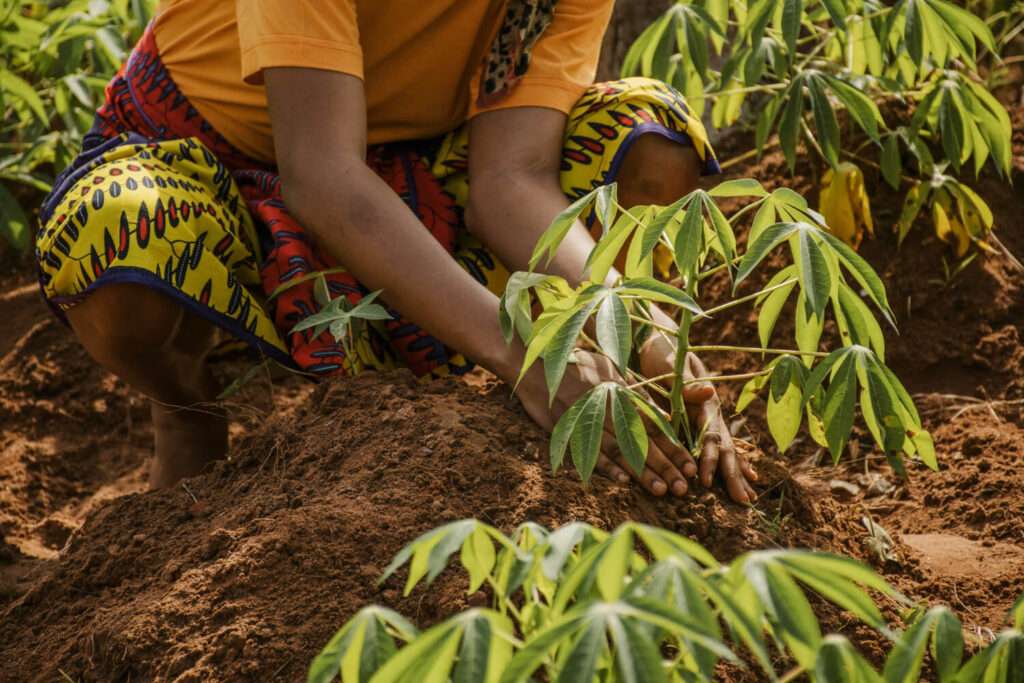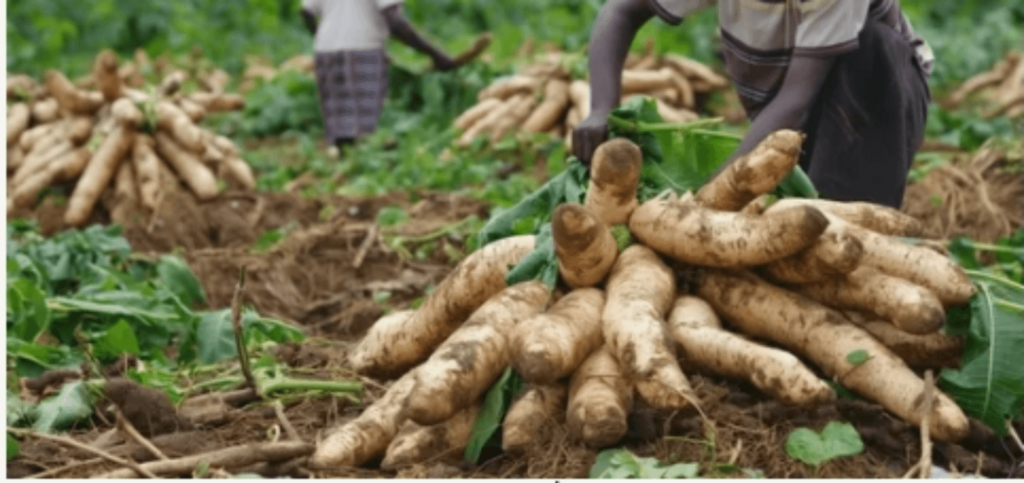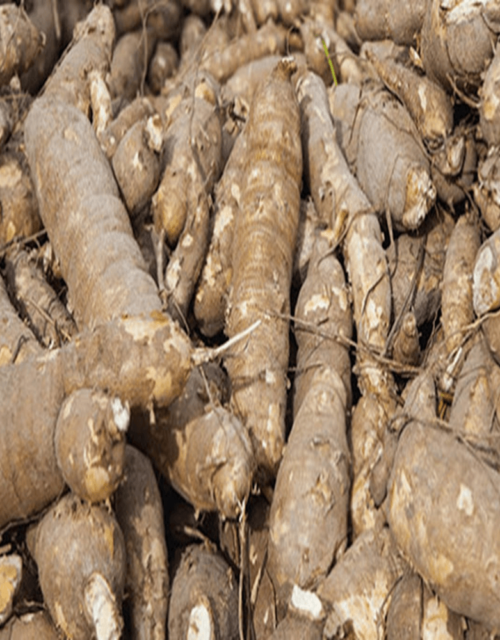Cassava Farming in Nigeria: Transforming Nigeria’s Agricultural Landscape

Nigeria, often called the “Giant of Africa,” is not just a leader in population and economy, but also in agriculture. At the heart of this agricultural prowess lies a humble yet mighty crop: cassava. As you dive into the world of cassava farming in Nigeria, you’ll uncover a story of tradition, innovation, and immense potential.
Are you a budding entrepreneur eyeing the agricultural sector, an established farmer looking to diversify, or an investor seeking the next big opportunity? Understanding cassava’s role in Nigeria is crucial. Let’s embark on this journey to explore how cassava is shaping Nigeria’s present and future.
Table of Contents
The Green Gold: Cassava’s Significance in Nigeria
In this section, we’ll uncover the importance of cassava in the Nigerian economy and the populace at large. Thus, opening an avenue for cassava farming as a business model.
A Staple for Millions
Cassava isn’t just a crop in Nigeria; it’s a way of life. This versatile tuber feeds millions, forming the backbone of Nigerian cuisine. From the popular garri to the beloved fufu, cassava-based foods are found on tables nationwide. Engaging in cassava cultivation promises an enormous market for your tubers.
Economic Powerhouse
Nigeria leads the world in cassava production, contributing a staggering 20% of global output. This “green gold” isn’t just feeding the nation; it’s feeding the economy. Cassava farming in Nigeria is a multi-billion-naira industry, providing livelihoods for millions of farmers and traders.
Beyond Food: Industrial Applications
The potential of cassava extends far beyond the dinner plate. Its industrial applications are vast and growing:
- Starch Production: Cassava starch is used in everything from textiles to pharmaceuticals.
- Ethanol: As the world seeks alternative fuels, cassava-based ethanol is gaining traction.
- Animal Feed: Cassava peels, once discarded, are now recognized as valuable animal feed.
As a budding entrepreneur or a potential investor, you have varying market segments to market your products.
Export Potential
While Nigeria consumes most of its cassava production, the export market is ripe for expansion. With global demand for cassava derivatives on the rise, Nigerian farmers have an opportunity to tap into lucrative international markets.
Current Farming Practices: Tradition Meets Innovation
In this section, we’ll open up on common farming techniques used by cassava farmers in Nigeria. This will help you make a choice or creatively innovate a practice that will boost your yields.
Small-Scale Farming: The Backbone of Production
The majority of cassava farming in Nigeria is done by smallholder farmers. These resilient individuals, often working with limited resources, are the unsung heroes of Nigeria’s cassava revolution.
They make up over 70% of Nigeria’s cassava production, though at subsistence level, utilizing traditional tools and practices. Common traditional practices used include:
- Intercropping: Involve cultivating cassava with other crops on the same farmland. Some staple crops planted together are the likes of maize, melon, and sometimes, yam.
- Manual planting and harvesting: These small farm holders use manual farming techniques to clear, plant, weed, and harvest their crops. Common tools used here include cutlass, hoe, and spade.
- Reliance on rainfall for irrigation: One major limitation to this farming practice is reliance on natural rainfall. Thus, cultivation and harvest time is determined by rainfall which they cannot control.

The Rise of Commercial Cassava Farming
While smallholders dominate, there’s a growing trend towards large-scale commercial cassava farming in Nigeria. These operations are introducing:
- Mechanization for planting and harvesting: Rather than using traditional hoe and cutlass, the tractor is used to prepare the land for cultivation, planting, and harvesting.
- Improved irrigation systems: Irrigation system is used in the place of rainfall. This allows the farmer to control the amount of water required for optimal crop growth and yield.
- Advanced pest and disease management techniques: Rather than use hand and hoe to control pest and weed, pesticides and herbicides are used. Farmers also understand planting time and optimal nutrients required for optimal pest and disease control.
Varieties: A Blend of Old and New
In Nigeria, we cultivate a mix of cassava varieties, these include:
- Local Varieties: Usually prized for their taste and cultural significance. Small farmholders usually stick to the old varieties because of their availability. They also believe that they are susceptible to common diseases. Some of these local varieties such as Ayaya, Sunshine, Fineface, etc produce yields of between 30 and 38 tons per hectare.
- Improved Varieties: Developed for higher yield and disease resistance. These high-yielding varieties such as UMUCASS 42 and 43 produce yields of up to 49 and 53 tons per hectare. They also have good disease resistance to major pests and diseases that affect cassava in the country including cassava mosaic disease, cassava bacterial blight, etc. They also contain moderate levels of pro-vitamin A.
The International Institute of Tropical Agriculture (IITA) in Ibadan and National Root Crop Research Institute (NRCRI) in Umudike have been at the forefront of developing these improved varieties, significantly boosting productivity.

Processing: Adding Value at Every Step
The cassava value chain in Nigeria is evolving. Farmers are increasingly involved in the processing, and production of:
- Garri
- Cassava flour
- Cassava starch
- Ethanol
This vertical integration is opening new revenue streams and reducing post-harvest losses.
Challenges: Hurdles on the Path to Progress
Despite its significance, cassava farming in Nigeria faces several challenges. In this section, we’ll take a look at some of the challenges farmers face in their day-to-day farming.
1. Pest and Disease Management
Cassava is resilient, but not invincible. Farmers grapple with different diseases daily, among them are:
- Cassava mosaic disease (CMD) is caused by a virus that makes the leaves of the cassava plant turn yellow and mottled. It can stunt the growth of the plant and reduce the yield of cassava roots.
- Cassava Brown Streak Disease (CBSD) is a viral disease that affects cassava plants. It causes brown streaks or lines on the stems and leaves of the plant. The disease can significantly reduce the yield of cassava roots and can also cause the roots to rot.
- Cassava mealybug is a small, sucking insect that feeds on the sap of the cassava plant. It can weaken the plant and cause it to produce fewer and smaller roots.
- Cassava bacterial blight is caused by bacteria that enter the plant through wounds and cause the leaves to turn brown and wither. It can also cause the roots to rot.
- Cassava anthracnose is a fungal disease that causes brown spots on the leaves and stems of the cassava plant. It can weaken the plant and reduce its yield.
- Cassava green mite is a tiny spider-like creature that feeds on the leaves of the cassava plant. It can cause the leaves to turn yellow and dry out.
These diseases are threats that can devastate crops, leading to significant losses.
2. Post-Harvest Losses
Cassava’s perishability is a major challenge. Without proper storage and processing facilities, farmers can lose up to 40% of their harvest.
Post-harvest losses refer to the reduction in quality or quantity of cassava tubers after they are harvested. These losses can occur during storage, processing, or transportation. Some common causes of post-harvest losses include:
- Improper storage: Cassava tubers are highly perishable and require proper storage conditions to prevent spoilage. Improper storage can lead to rotting, drying, and other forms of deterioration.
- Pests and diseases: Cassava tubers are susceptible to various pests and diseases that can cause significant losses. These include storage pests, fungal infections, and bacterial rots.
- Mechanical damage: Rough handling during harvest, transportation, or processing can cause physical damage to cassava tubers, leading to losses and reducing their quality.
- Improper processing: Incorrect processing methods can result in the loss of nutrients, flavor, or texture in cassava products.
To minimize post-harvest losses, it is essential to adopt proper storage practices, implement effective pest and disease control measures, handle cassava tubers carefully, and use appropriate processing techniques.
3. Market Price Fluctuations
The cassava market can be volatile. Prices fluctuate based on supply, demand, and even government policies.
For example, as of September 2024, the retail price of cassava in Nigeria ranges between ₦180.37 and ₦270.55 per kilogram. Similarly, according to Business Day, the price of a 50kg bag of yellow garri surged from ₦18,000 in December 2023 to ₦37,500 in March 2024.
This price fluctuations can be a challenge for aspiring entrepreneurs and farmers to plan and invest.
4. Limited Access to Modern Farming Techniques
As we’ve earlier explained. many smallholder farmers lack access to:
- Improved cassava varieties
- Modern farming equipment
- Agricultural extension services
This limits their productivity and profitability.
5. Climate Change
Changing weather patterns are affecting cassava cultivation. Unpredictable rainfall and increasing temperatures pose new challenges for farmers.
Market Opportunities: A World of Possibilities
The market for cassava and its derivatives is expanding rapidly, both within Nigeria and internationally. This section explores the exciting opportunities awaiting cassava farmers and entrepreneurs.
Domestic Market: A Hunger for Growth
1. Food Security
Nigeria’s growing population, currently over 200 million, ensures a steady demand for cassava as a staple food. Urban migration is driving increased demand for convenient, cassava-based foods like garri and fufu.
2. Industrial Applications
- Textile Industry: Cassava starch is a key ingredient in textile production, used for sizing and finishing fabrics.
- Pharmaceuticals: The pharmaceutical industry uses cassava starch as a binding agent in pill production.
- Paper Industry: Cassava starch finds application in paper and cardboard manufacturing.
3. Ethanol Production
With Nigeria pushing for greener energy solutions, cassava-based ethanol production is on the rise. The government’s E10 policy, which mandates 10% ethanol blend in gasoline, creates a massive market for cassava-derived ethanol. This policy aims to reduce greenhouse gas emissions, improve air quality, and promote the use of renewable energy sources.
4. Animal Feed
The livestock industry’s growth is driving demand for cassava peels and other by-products as animal feed.
International Markets: Going Global
- China: The Hungry Dragon China’s demand for cassava chips and pellets for animal feed and ethanol production presents a huge export opportunity. In 2019, China imported over 90% of its cassava chips from Thailand and Vietnam – Nigeria can tap into this market.
- European Union The EU’s push for bio-based products opens doors for Nigerian cassava starch and ethanol exports.
- Other African Countries With the African Continental Free Trade Area (AfCFTA) agreement, Nigerian cassava products can more easily reach other African markets, especially in cassava-deficient countries.
- United States The growing market for gluten-free products in the US presents an opportunity for cassava flour exports.

Value-Added Products: The Future of Cassava
The real opportunity lies in value-added cassava products:
- High-Quality Cassava Flour (HQCF) HQCF can partially replace wheat flour in bakery products, opening a huge market as Nigeria seeks to reduce wheat imports.
- Modified Cassava Starch Used in food processing, pharmaceuticals, and other industries. Modified starch commands higher prices than raw cassava.
- Cassava-Based Adhesives Eco-friendly adhesives made from cassava are gaining popularity in various industries.
- Sorbitol This sweetener, produced from cassava, is used in sugar-free foods and personal care products.
Government Support and Initiatives: Cultivating Success
The Nigerian government recognizes cassava’s potential and has implemented several supportive policies and initiatives. In this section, we shall explore some of the ways the government is contributing to improve cassava farming in Nigeria.
1. Presidential Initiative on Cassava (PIC)
Launched in 2002, this initiative aims to promote cassava as a viable export crop and industrial raw material. Key aspects include:
- Encouraging the use of cassava flour in bread-making
- Promoting cassava chip export
- Supporting cassava-based ethanol production
2. Agricultural Transformation Agenda (ATA)
Introduced in 2011, the ATA focuses on treating agriculture as a business. For cassava, this means:
- Providing improved cassava varieties to farmers
- Establishing staple crop processing zones
- Facilitating access to finance for cassava farmers and processors
3. Anchor Borrowers’ Programme (ABP)
Launched by the Central Bank of Nigeria in 2015, the ABP provides loans to smallholder farmers. Cassava farmers can access:
- Low-interest loans
- Improved seedlings
- Extension services
4. Nigeria Cassava Growers Association (NCGA)
The government supports the NCGA, which helps farmers by:
- Providing access to improved cassava varieties
- Offering training on best farming practices
- Facilitating market access for members
5. Research Support
The government funds cassava research through institutions like:
- International Institute of Tropical Agriculture (IITA)
- National Root Crops Research Institute (NRCRI)
These institutions develop improved cassava varieties and farming techniques.
6. Export Promotion
The Nigerian Export Promotion Council (NEPC) assists cassava exporters by:
- Providing market intelligence
- Facilitating participation in international trade fairs
- Offering export incentives
7. Cassava Bread Fund
This initiative promotes the inclusion of cassava flour in bread making by:
- Providing equipment to bakers
- Offering training on cassava-wheat flour blending
- Creating awareness about the benefits of cassava bread
The Impact of Government Initiatives
These government efforts have yielded significant results:
- Increased Production: Nigeria’s cassava production has more than doubled since 2000.
- Job Creation: The cassava value chain now employs millions of Nigerians.
- Technological Adoption: More farmers are using improved varieties and modern farming techniques.
- Industrial Growth: There’s been a rise in cassava processing industries, from small-scale to large industrial plants.
However, challenges remain. Many smallholder farmers still struggle to access these benefits due to:
- Limited awareness of government programs
- Bureaucratic hurdles in accessing support
- Insufficient funds to meet all farmers’ needs
Leveraging Government Support for Your Cassava Farming Business
To make the most of these opportunities and government initiatives:
- Stay informed about current policies and programs
- Join relevant associations like the NCGA
- Attend agricultural workshops and training sessions
- Explore financing options through the ABP and other government-backed schemes
- Consider value-addition to tap into growing markets
Remember, success in cassava farming requires more than just government support. It demands careful planning, market understanding, and effective execution.
That’s where our comprehensive Yam and Cassava Farming Business Plan comes in handy. It provides you with the roadmap to navigate these opportunities and challenges, helping you build a thriving cassava farming business.
The Road Ahead: Opportunities in Cassava Farming
Despite these challenges, the future of cassava farming in Nigeria is bright. Here’s why:
1. Government Support
The Nigerian government recognizes cassava’s potential. Initiatives like the Cassava Bread Fund and the Agricultural Transformation Agenda are providing crucial support to the sector.
2. Technological Advancements
From drought-resistant varieties to mobile apps for farmers, technology is revolutionizing cassava farming in Nigeria.
3. Growing Industrial Demand
As industries discover new uses for cassava, demand is set to soar. This presents a huge opportunity for farmers to expand their operations.
4. Export Markets
With the African Continental Free Trade Area (AfCFTA) agreement, Nigerian cassava farmers have unprecedented access to continental markets.
Conclusion: Your Role in the Cassava Revolution
Cassava farming in Nigeria is more than an agricultural activity; it’s a gateway to economic empowerment and food security. Whether you’re considering starting a cassava farm, expanding your existing operation, or investing in the sector, the time to act is now.
But success in this dynamic field requires more than just enthusiasm. It demands knowledge, strategy, and careful planning. That’s where our comprehensive Yam and Cassava Farming Business Plan comes in.
This meticulously researched plan provides:
- Detailed market analysis
- Financial projections
- Operational strategies
- Marketing tactics
Armed with this plan, you’ll be well-equipped to navigate the challenges and seize the opportunities in Nigeria’s cassava farming sector.
Don’t just be a spectator in Nigeria’s agricultural revolution. Be a part of it. Download our Yam and Cassava Farming Business Plan today and take your first step towards agricultural success.
About the Author: Kelechi Agomuo is a Business analyst with over 10 years of experience in the Nigerian agricultural and business sector. He has helped numerous smallholder farmers and agribusinesses achieve success in cassava, maize, and yam farming.
Featured Articles:
- How Profitable is Cassava Farming in Nigeria?
- Yam Farming in Nigeria: A Comprehensive Guide
- Top 10 Challenges Facing Nigerian Farmers (And How to Overcome Them)









